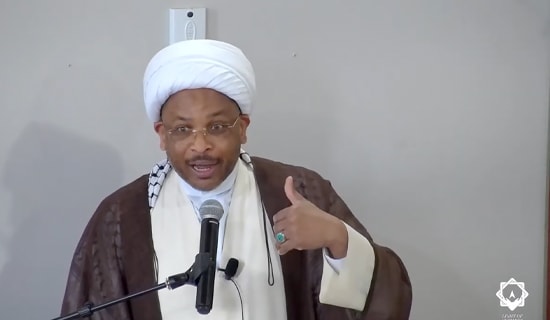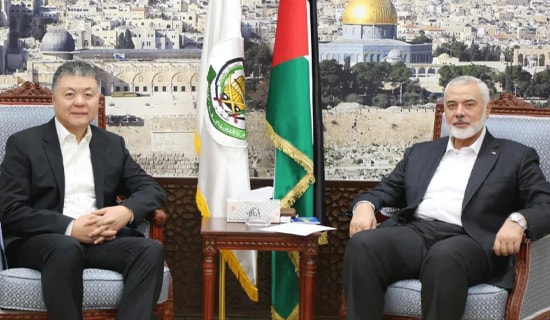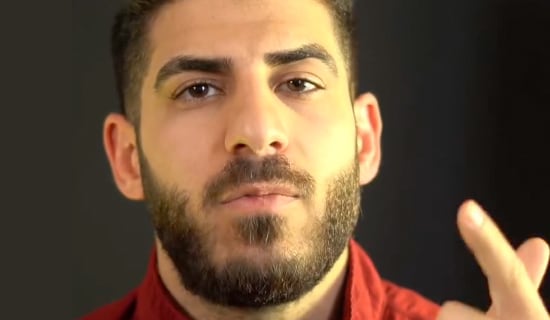
The propaganda of the Islamic State is entering an interesting new phase, as the "physical" Caliphate comes under unprecedented pressure and some ISIS franchises, such as the one in Libya, suffer major reverses. Despite overheated rhetoric by some in the West, and seemingly wishful thinking by some in the media, ISIS propaganda does not dwell on the new U.S. president and his policies.[1] ISIS videos do focus extensively on the battle to defend its territories in places like Mosul and Raqqa. Recent videos have also lovingly focused on weaponized drones and on encouraging more suicide bombers, singling out the use of young boys or old men or even non-combatant administrative personnel.
The sectarian dimension of the ISIS message is never far away. Violence and threats against Iraqi Shi'a or Kurdish Peshmerga are a constant. Descriptions of "secular Turkey and "atheist PKK" are meant to be insults. Anti-ISIS Sunni "clerics of evil," some of them quite extreme, are to be targeted and killed. One recent video focused on the travails of Rohingya Muslims at the hands of Burmese Buddhist, or Nigerian Sunnis versus Christians and Shi'a, while other visual material lingered over supposed civilian deaths inside the "Caliphate" at the hands of "Crusader" airstrikes.
The ISIS branch in Egypt, seeking to make the jump from Sinai to the Nile Valley, recently focused on an old chestnut beloved by Egyptian (and non-Egyptian) jihadis for decades, targeting the Coptic Orthodox Church.[2]
A 21-minute video released by "ISIS Egypt" on February 19, 2017 is an important reminder of how ISIS propaganda combines several strands of argument in one product and how it seeks to exploit and piggyback on existing fissures and prejudices in local societies. The title of the video, "And Fight Against the Polytheists Collectively," taken from the Quran's Surah Al-Tawba, Verse 36, is one of those verses favored by jihadis as justifying ongoing violence against non-Muslims.
A relentless attack on Coptic Christians, the video presupposes that there is fertile ground for such a message, and that there is deep-seated and widespread bigotry against this religious minority among many of Egypt's Muslims. None of the themes that ISIS addresses are new, and all of them could be found in jihadi anti-Copt propaganda in the 1970s, during a period when these groups began to proliferate in Sadat's Egypt and targeted Christians for robbery and death, in addition to killing government officials.[3]
The intended message against the Copts is political, economic and religious. They are first shown as engaged in behavior calculated to enrage: demonstrating for their rights, carrying crosses in the street, worshipping, declaring themselves to be the "original Egyptians." The narrator describes them as the "largest Crusader minority in the Middle East" but much smaller than the Copts claim to be, "only 4 million."
The supposed favored economic role of Copts is emphasized: they "control more than 40% of the Egyptian economy," while images of some wealthy Copts and their businesses are shown.
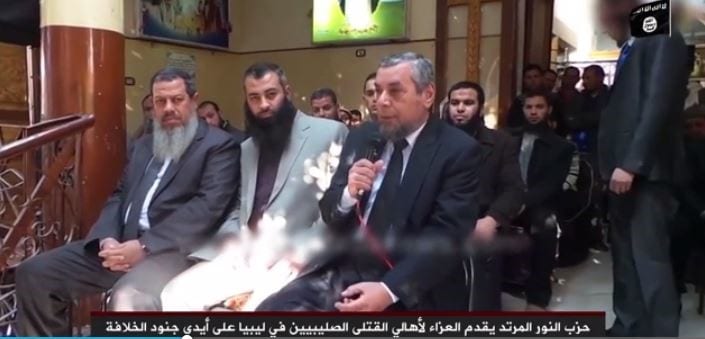
The video shows Egyptian officials saying nice things to Copts – such as offering condolences after a December 2016 church bombing by ISIS. Not only are Egyptian President Al-Sisi and regime clerics featured, but so is former president Morsi and his "Apostate Brotherhood" (Muslim Brotherhood) and the Salafi Islamist Nur Party. Christian leaders, including Coptic Pope Tawadros II, are in turn shown praising the Egyptian government and its "tyrant" president. The scene then shifts to images of Muslims supposedly killed in Sinai by Egyptian airstrikes. The trick is to both discredit anyone who has anything decent to say about Coptic Christians and to tie the Copts to the regime, a widespread calumny found beyond the ranks of ISIS.[4]
The political and economic attack is built upon a clear framework of religious justification. Verses from the Quran, from Hadith, and from history – the Pact of Omar – are used to advance the notion that this is a people that has collectively broken any sort of possible protection it could have under Muslim rule and is to be attacked with impunity. The video goes beyond chapter and verse, telling us that "Allah has called for the extermination of every Apostate (Murtad) and Disbeliever (Kafir) and the cleansing of the earth from them."
The viewer is given a heavy dose of Christian imagery intended to repel and incite bigoted Muslims – Copts taking communion, praying, and images of crosses and churches.
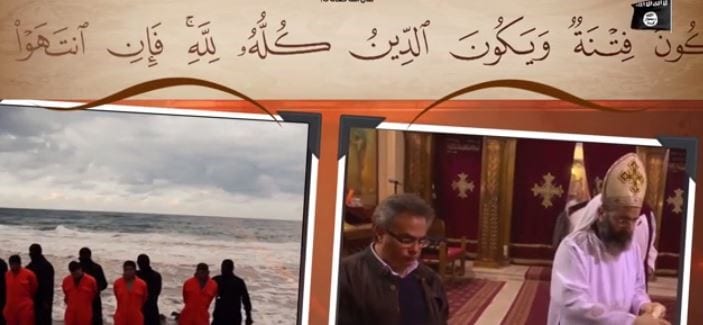
SUPPORT OUR WORK

Not satisfied with exercising political and economic power, the video claims, "among the worst things these stubborn infidels do" is to insult the Prophet Muhammad and Islam in the local media and on satellite television.
Footage is shown of the controversial Coptic Orthodox priest Zakaria Butros, who has worked for decades to convert Muslims to Christianity, apparently with some success.[5]

The video closes by gloatingly dwelling on the December 2016 ISIS suicide bombing of a Coptic church in Cairo that killed 29, mostly women and children. It notes that the Christians asked for protection from Al-Sisi but "he can't protect his own soldiers in Sinai." Copts are to be targeted anywhere and at any time possible, and ISIS will liberate Cairo, bring bombings to the capital, liberate its prisoners. "And as for the Crusaders in Egypt, the operation which targeted your pagan temple is only the first, Allah willing, for you are our priority and our preferred prey."
The most remarkable thing about this video is not its toxic content but its target. Copts in Egypt are indeed the largest Christian minority in the Middle East, but they are mostly a people without any sort of power, at the mercy of whoever rules Egypt, and have been so for centuries. A religious minority with no weapons, no army, no secret police, no political agency of any sort is singled out for violence not so much for what they do, but of who they are. This was, of course, the message in the previous ISIS video targeting Coptic Christians, the February 2015 slaughter of 21 poor Egyptian migrant workers in Libya by the ISIS branch there.[6]
The second key point about the video is its purported appeal to Muslims. Like previous ISIS propaganda and actions against non-Muslims elsewhere, this is a bet that Muslim bigotry resonates and that the potential pool of people in Muslim-majority countries who despise and fear their neighbors is large and malleable enough to matter. Despite the palpable viciousness of the threat, it is also, of course, lightly clothed in the usual vaguely reassuring discourse of jizya and ahl al-dhimmah straight out of a Jonathan Brown lecture.[7]
What are the challenges for those who want to counter such a propaganda approach? One step is to understand the psychology of dehumanization inherent in ISIS media.[8] Such a process is, of course, quite common among terrorist groups, including Salafi-jihadis. Coptic Christians are targeted for slaughter as a group, their denomination is described as an "enemy church," and the alleged transgression of any Copt anywhere is grounds for death against any other. And the video's opening prominently features a non-Copt, Pope Francis, which shows that this discourse looks beyond Egypt as well.
The process by which ISIS and similar groups treats humans as beasts is, of course, deeply grounded in the language of Islam. It is steeped in the rhetoric of the faith. While we are told – and it is no doubt true – by many Muslims that Quranic verses such as the title of this video are used by ISIS out of context, the fact remains that they feel empowered to do so. They believe that their interpretation of scripture is plausible enough to have already been accepted by a considerable number of their coreligionists.
So while understanding why ISIS dehumanizes the Other is important, so is comprehending how it uses the tools to accomplish this goal. These include the power inherent in the jihadi use of such core concepts as infidelity (and infidels), polytheism, apostasy, loyalty and disavowal, and holy war. It is not enough to do, as many Muslims try, to simply call ISIS kharijites and move on. That is an important step. The "high ground" in the battle for authenticity must be seized by aggressively contesting all these concepts.
While a certain level of anti-Coptic prejudice is indeed well established in Egypt and the Middle East, ISIS is wagering that these atavistic feelings can be productively channeled in its favor. Since the video, the carnage has continued, and on February 22, 2017, AP reported the kidnapping and burning alive of two Coptic Christian men in Sinai.[9]
The Islamic State seeks to combine bigotry, a generalized sense of Islamic supremacy, dreams of victory, and political grievance into a potent formula to expand its appeal, at a time when it is under great military pressure. One can only hope that the Islamic State is indeed deeply and fatefully mistaken about the Muslim people they claim to care so much about, and that Egyptian concord and patriotism is much stronger than hate.
*Alberto M. Fernandez is Vice-President of MEMRI.
[1] Theatlantic.com, February 1, 2017.
[2] MEMRI Daily Brief No. 79, Coptophobia, February 19, 2016.
[3] Alberto M. Fernandez, "In the Year of the Martyrs: Anti-Coptic Violence in Egypt, 1988-1993," paper presented at the Middle East Studies Association Annual Meeting, San Francisco, California, November 18-20, 2001
[4] MEMRI TV Clip No. 5691, N.Y.-Based Egyptian-American Activist Ayat Oraby Calls For Economic Boycott Of Copts: The Crescent Must Always Be On Top Of The Cross, September 19, 2016.
[5] Islam-christianity.net/
[6] Guardian.com, February 15, 2015.
[7] The Washington Post, February 17, 2017.
[8] Annualreviews.org, January 2014
[9] Associated Press, February 22, 2017.


